Effect of Conical Strip Inserts and ZrO2/DI-Water Nanofluid on Heat Transfer Augmentation: An Experimental Study
Abstract
:1. Introduction
2. Methodology
2.1. Analysis Techniques
2.2. Preparation of Nanofluids
2.3. Fabrication of Staggered Conical Strip Inserts
2.4. Twist Ratio (Y)
3. Experimentation
3.1. Details of the Experimental Facility
3.2. Experimental Procedure
3.3. Data Processing
3.4. Uncertainty Analysis
4. Results and Discussion
4.1. Plain Tube Data for Validation Study under Laminar Flow
4.2. The Effect of the Staggered Conical Strip Insert with Both Forward and Backward Direction and Nanofluid on Heat Transfer
4.3. Effect of the Staggered Conical Strip Insert with Both Forward and Backward Directionsand Nanofluid on the Friction Factor
4.4. Effect of the Staggered Conical Strip Insert with Both Forward and Backward Directions and Nanofluid on the Thermal Performance Factor (ɳ)
4.5. Development of Empirical Correlations
5. Conclusions
- The staggered conical strip inserts with a backward direction incorporated in the test section exhibited the higher Nusselt numbers and friction factors compared to that of the forward direction, because the inserts interrupted the thermal and hydraulic boundary layer, thus producing more swirl flow.
- The conical strip insert is a passive heat transfer enhancement technique to amplify the fluid turbulence with a negligible increase in the pressure drop. The uniform dispersion of higher thermal conductive nanoparticles in the heat transfer fluid further enhances its effective thermal conductivity due to ballistic phonon motion and Brownian motion. The maximum heat transfer and pressure drop in the case of the Y = 2.5 twist ratio with 0.5 vol.% of nanofluid was 145% and15.07 times, respectively.
- The thermal performance factor was substantially acquired with values of more than unity, which showed the merits of the staggered conical strip inserts in terms of net-energy savings.
- The predicted values from the correlation equation for the Nusselt number and friction factor were estimated with minimum deviations.
- The present investigation can be further extended with hybrid nanofluid and conical strip inserts employed in other kinds of heat exchangers, such as shell and tube heat exchangers and radiators for industrial heat transfer applications.
Author Contributions
Funding
Acknowledgments
Conflicts of Interest
Nomenclature
| A | Area of cross-section (m2) | TPF | Thermal performance factor. |
| cp | Specific heat (J/kg K) | v | Velocity of fluid (m/s) |
| Di | Diameter of test section (m) | V | Voltage (V) |
| f | Friction factor | Y | Twist ratio |
| h | Convective heat transfer coefficientcoefficient coefficient (W/m2K) | Greek Symbols | |
| I | Current (A) | Δp | Pressure drop (Pa) |
| k | Thermal conductivity (W/m K) | µ | Dynamic viscosity (kg/m2 s) |
| L | Length of test section (m) | ρ | Density (kg./m3) |
| m | Mass flow rate (kg/s) | Subscripts | |
| Nu | Nusselt number | bf | Basefluid |
| P | Pitch | f | Fluid Id |
| Pr | Prandtl number | in | Inlet |
| q″ | Actual heat flux (W/m2) | nf | Nanofluid |
| Q | Heat input (W) | np | Nanoparticle |
| Re | Reynolds number | out | Outlet |
| T | Temperature (°C) | p | plain tube |
| Abbreviations | |||
| FWD | Forward | ||
| BWD | Backward | ||
| DI | Deionized | ||
References
- Suganthi, K.; Rajan, K. Metal oxide nanofluids: Review of formulation, thermo-physical properties, mechanisms, and heat transfer performance. Renew. Sustain. Energy Rev. 2017, 76, 226–255. [Google Scholar] [CrossRef]
- Jang, S.P.; Choi, S.U.S. Role of Brownian motion in the enhanced thermal conductivity of nanofluids. Appl. Phys. Lett. 2004, 84, 4316. [Google Scholar] [CrossRef]
- Eid, M.R.; Mahny, K.L. Flow and heat transfer in a porous medium saturated with a Sisko nanofluid over a nonlinearly stretching sheet with heat generation/absorption. Heat Transf. Asian Res. 2018, 47, 54–71. [Google Scholar] [CrossRef]
- Esfahani, N.N.; Toghraie, D.; Afrand, M. A new correlation for predicting the thermal conductivity of ZnO–Ag (50%–50%)/water hybrid nanofluid: An experimental study. Powder Technol. 2018, 323, 367–373. [Google Scholar] [CrossRef]
- Ding, M.; Liu, C.; Rao, Z. Experimental investigation on heat transfer characteristic of TiO2-H2O nanofluid in microchannel for thermal energy storage. Appl. Therm. Eng. 2019, 160, 114024. [Google Scholar] [CrossRef]
- Fares, M.; Mohammad, A.M.; Mohammed, A.S. Heat transfer analysis of a shell and tube heat exchanger operated with grapheme nanofluids. Case Stud. Therm. Eng. 2020, 18, 100584. [Google Scholar] [CrossRef]
- Ajeel, R.K.; Salim, W.I.; Sopian, K.; Yusoff, M.Z.; Hasnan, K.; Ibrahim, A.; Al-Waeli, A.H. Turbulent convective heat transfer of silica oxide nanofluid through corrugated channels: An experimental and numerical study. Int. J. Heat Mass Transf. 2019, 145, 118806. [Google Scholar] [CrossRef]
- Gravndyan, Q.; Akbari, O.A.; Toghraie, D.; Marzban, A.; Mashayekhi, R.; Karimi, R.; Pourfattah, F. The effect of aspect ratios of rib on the heat transfer and laminar water/TiO2nanofluid flow in a two-dimensional rectangular microchannel. J. Mol. Liq. 2017, 236, 254–265. [Google Scholar] [CrossRef]
- Ajeel, R.K.; Salim, W.I.; Hasnan, K. Experimental and numerical investigations of convection heat transfer in corrugated channels using alumina nanofluid under a turbulent flow regime. Chem. Eng. Res. Des. 2019, 148, 202–217. [Google Scholar] [CrossRef]
- Hardika, B.K.; Prabhu, S.V. Experimental correlation for critical heat flux in helical coils. Nucl. Eng. Des. 2020, 368, 110759, reprinted in Int. J. Heat Mass Transf. 2020, 146, 118723. [Google Scholar] [CrossRef]
- Salem, M.; Eltoukhey, M.; Ali, R.; Elshazly, K.M. Experimental investigation on the hydrothermal performance of a double-pipe heat exchanger using helical tape insert. Int. J. Therm. Sci. 2018, 124, 496–507. [Google Scholar] [CrossRef]
- Sivashanmugam, P.; Nagarajan, P. Studies on heat transfer and friction factor characteristics of laminar flow through a circular tube fitted with right and left helical screw-tape inserts. Exp. Therm. Fluid Sci. 2007, 32, 192–197. [Google Scholar] [CrossRef]
- Wang, Y.; Alvarado, J.L.; Terrell, W., Jr. Thermal performance of helical coils with reversed loops and wire coil inserts. Int. J. Heat Mass Transf. 2020, 146, 118723. [Google Scholar] [CrossRef]
- Hamid, K.A.; Azmi, W.; Mamat, R.; Sharma, K. Heat transfer performance of TiO2–SiO2nanofluids in a tube with wire coil inserts. Appl. Therm. Eng. 2019, 152, 275–286. [Google Scholar] [CrossRef]
- Pérez-García, J.; García, A.; Herrero-Martín, R.; Solano, J. Experimental correlations on critical Reynolds numbers and friction factor in tubes with wire-coil inserts in laminar, transitional and low turbulent flow regimes. Exp. Therm. Fluid Sci. 2018, 91, 64–79. [Google Scholar] [CrossRef]
- Sundar, L.S.; Bhramara, P.; Kumar, N.R.; Singh, M.K.; Sousa, A. Experimental heat transfer, friction factor and effectiveness analysis of Fe3O4 nanofluid flow in a horizontal plain tube with return bend and wire coil inserts. Int. J. Heat Mass Transf. 2017, 109, 440–453. [Google Scholar] [CrossRef]
- Bahiraei, M.; Mazaheri, N.; Aliee, F.; Safaei, M.R. Thermo-hydraulic performance of a biological nanofluid containing graphene nanoplatelets within a tube enhanced with rotating twisted tape. Powder Technol. 2019, 355, 278–288. [Google Scholar] [CrossRef]
- Moya-Rico, J.; Molina, A.; Belmonte, J.; Tendero, J.C.; Almendros-Ibáñez, J. Experimental characterization of a double tube heat exchanger with inserted twisted tape elements. Appl. Therm. Eng. 2020, 174, 115234. [Google Scholar] [CrossRef]
- Nakhchi, M.; Esfahani, J. Performance intensification of turbulent flow through heat exchanger tube using double V-cut twisted tape inserts. Chem. Eng. Process. Process Intensif. 2019, 141, 107533. [Google Scholar] [CrossRef]
- Murugesan, P.; Mayilsamy, K.; Suresh, S. Heat transfer in tubes fitted with trapezoidal-cut and plain twisted tape inserts. Chem. Eng. Commun. 2011, 198, 886–904. [Google Scholar] [CrossRef]
- Garg, M.; Nautiyal, H.; Khurana, S.; Shukla, M. Heat transfer augmentation using twisted tape inserts: A review. Renew. Sustain. Energy Rev. 2016, 63, 193–225. [Google Scholar] [CrossRef]
- Esmaeilzadeh, E.; Almohammadi, H.; Nokhosteen, A.; Motezaker, A.; Omrani, A.N. Study on heat transfer and friction factor characteristics of γ-Al2O3/water through circular tube with twisted tape inserts with different thicknesses. Int. J. Therm. Sci. 2014, 82, 72–83. [Google Scholar] [CrossRef]
- Mohammed, H.A.; Abuobeida, I.A.A.; Vuthaluru, H.B.; Liu, S. Two-phase forced convection of nanofluids flow in circular tubes using convergent and divergent conical rings inserts. Int. Commun. Heat Mass Transf. 2019, 101, 10–20. [Google Scholar] [CrossRef]
- Rathnakumar, P.; Iqbal, S.M.; Michael, J.J.; Suresh, S. Study on performance enhancement factors in turbulent flow of CNT/water nanofluid through a tube fitted with helical screw louvered rod inserts. Chem. Eng. Process. Process. Intensif. 2018, 127, 103–110. [Google Scholar] [CrossRef]
- Bahiraei, M.; Mazaheri, N.; Alighardashi, M. Development of chaotic advection in laminar flow of a non-Newtonian nanofluid: A novel application for efficient use of energy. Appl. Therm. Eng. 2017, 124, 1213–1223. [Google Scholar] [CrossRef]
- Li, P.; Liu, Z.; Liu, W.; Chen, G. Numerical study on heat transfer enhancement characteristics of tube inserted with centrally hollow narrow twisted tapes. Int. J. Heat Mass Transf. 2015, 88, 481–491. [Google Scholar] [CrossRef]
- Amani, M.; Amani, P.; Kasaeian, A.; Mahian, O.; Yan, W.-M. Two-phase mixture model for nanofluid turbulent flow and heat transfer: Effect of heterogeneous distribution of nanoparticles. Chem. Eng. Sci. 2017, 167, 135–144. [Google Scholar] [CrossRef]
- Babu, J.R.; Kumar, K.K.; Rao, S.S. State-of-art review on hybrid nanofluids. Renew. Sustain. Energy Rev. 2017, 77, 551–565. [Google Scholar] [CrossRef]
- Kumar, D.D.; Arasu, A.V. A comprehensive review of preparation, characterization, properties and stability of hybrid nanofluids. Renew. Sustain. Energy Rev. 2018, 81, 1669–1689. [Google Scholar] [CrossRef]
- Das, P.K. A review based on the effect and mechanism of thermal conductivity of normal nanofluids and hybrid nanofluids. J. Mol. Liq. 2017, 240, 420–446. [Google Scholar] [CrossRef]
- Pal, S.; Saha, S.K. Laminar fluid flow and heat transfer through a circular tube having spiral ribs and twisted tapes. Exp. Therm. Fluid Sci. 2015, 60, 173–181. [Google Scholar] [CrossRef]
- Man, C.; Lv, X.; Hu, J.; Sun, P.; Tang, Y. Experimental study on effect of heat transfer enhancement for single-phase forced convective flow with twisted tape inserts. Int. J. Heat Mass Transf. 2017, 106, 877–883. [Google Scholar] [CrossRef]
- You, Y.; Fan, A.; Liu, W.; Huang, S. Thermo-hydraulic characteristics of laminar flow in an enhanced tube with conical strip inserts. Int. J. Therm. Sci. 2012, 61, 28–37. [Google Scholar] [CrossRef]
- Liu, P.; Zheng, N.; Shan, F.; Liu, Z.; Liu, W. Heat transfer enhancement for laminar flow in a tube using bidirectional conical strip inserts. Int. J. Heat Mass Transf. 2018, 127, 1064–1076. [Google Scholar] [CrossRef]
- Pourramezan, M.; Ajam, H. Modeling for thermal augmentation of turbulent flow in a circular tube fitted with twisted conical strip inserts. Appl. Therm. Eng. 2016, 105, 509–518. [Google Scholar] [CrossRef]
- Chopkar, M.; Das, P.; Manna, I. Thermal characterization of a nanofluid comprising nanocrystalline ZrO2 dispersed in water and ethylene glycol. Philos. Mag. 2007, 87, 4433–4444. [Google Scholar] [CrossRef]
- Mohammed, H.A.; Hasan, H.A.; Wahid, M. Heat transfer enhancement of nanofluids in a double pipe heat exchanger with louvered strip inserts. Int. Commun. Heat Mass Transf. 2013, 40, 36–46. [Google Scholar] [CrossRef]
- Aghayari, R.; Maddah, H.; Zarei, M.; Dehghani, M.; Mahalle, S.G.K. Heat transfer of nanofluid in a double pipe heat exchanger. Int. Sch. Res. Not. 2014, 2014, 1–7. [Google Scholar] [CrossRef] [Green Version]
- Arani, A.A.A.; Amani, J. Experimental study on the effect of TiO2—Water nanofluid on heat transfer and pressure drop. Exp. Therm. Fluid Sci. 2012, 42, 107–115. [Google Scholar] [CrossRef]
- Iqbal, S.M.; Raj, C.S.; Michael, J.J.; Irfan, A.M. A comparative investigation of Al2O3/H2O, SiO2/H2O and ZrO2/H2O nanofluid for heat transfer applications. Dig. J. Nanomater. Biostruct. 2017, 12, 255–263. [Google Scholar]
- Pak, B.C.; Cho, Y.I. Hydrodynamic and heat transfer study of dispersed fluids with submicron metallic oxide particles. Exp. Heat Transf. Int. J. 1998, 11, 151–170. [Google Scholar] [CrossRef]
- Xuan, Y.; Roetzel, W. Conceptions for heat transfer correlation of nanofluids. Int. J. Heat Mass Transf. 2000, 43, 3701–3707. [Google Scholar] [CrossRef]
- Nakhchi, M.; Esfahani, J. Numerical investigation of turbulent Cu-water nanofluid in heat exchanger tube equipped with perforated conical rings. Adv. Powder Technol. 2019, 30, 1338–1347. [Google Scholar] [CrossRef]
- Fan, A.; Deng, J.; Guo, J.; Liu, W. A numerical study on thermo-hydraulic characteristics of turbulent flow in a circular tube fitted with conical strip inserts. Appl. Therm. Eng. 2011, 31, 2819–2828. [Google Scholar] [CrossRef]
- Minakov, A.; Guzei, D.; Meshkov, K.; Popov, I.; Shchelchkov, A. Experimental study of turbulent forced convection of nanofluid in channels with cylindrical and spherical hollows. Int. J. Heat Mass Transf. 2017, 115, 915–925. [Google Scholar] [CrossRef] [Green Version]
- Sun, B.; Zhang, Z.; Yang, D. Improved heat transfer and flow resistance achieved with drag reducing Cu nanofluids in the horizontal tube and built-in twisted belt tubes. Int. J. Heat Mass Transf. 2016, 95, 69–82. [Google Scholar] [CrossRef]
- Ding, Y.; Chen, H.; He, Y.; Lapkin, A.; Yeganeh, M.; Šiller, L.; Butenko, Y.V. Forced convective heat transfer of nanofluids. Adv. Powder Technol. 2007, 18, 813–824. [Google Scholar] [CrossRef]
- Mirfendereski, S.; Abbassi, A.; Saffar-Avval, M. Experimental and numerical investigation of nanofluid heat transfer in helically coiled tubes at constant wall heat flux. Adv. Powder Technol. 2015, 26, 1483–1494. [Google Scholar] [CrossRef]
- Usui, H. Enhancement of heat transfer by a combination of internally grooved rough tube and twisted tape. Int. Chem. Eng. 1986, 26, 97–104. [Google Scholar]
- Kine, S.J.; McClintock, F.A. Describing uncertainties in single-sample experiments. J. Mech. Eng. 1953, 3, 3–8. [Google Scholar]
- Ponnada, S.; Subrahmanyam, T.; Naidu, S. A comparative study on the thermal performance of water in a circular tube with twisted tapes, perforated twisted tapes and perforated twisted tapes with alternate axis. Int. J. Therm. Sci. 2019, 136, 530–538. [Google Scholar] [CrossRef]
- Shah, R.K. Thermal entry length solutions for the circular tube and parallel plates. In Proceedings of the Third National Heat Mass Transfer Conference, Indian Institute of Technology, Bombay, Indian, 11–13 December 1975; p. 1, Paper No. HMT-11-75. [Google Scholar]
- Kristiawan, B.; Santoso, B.; Wijayanta, A.T.; Aziz, M.; Miyazaki, T. Heat transfer enhancement of TiO2/water nanofluid at laminar and turbulent flows: A numerical approach for evaluating the effect of nanoparticle loadings. Energies 2018, 11, 1584. [Google Scholar] [CrossRef] [Green Version]
- Ahmad, S.; Abdullah, S.; Sopian, K. Numerical and experimental analysis of the thermal performances of SiC/water and Al2O3/water nanofluid inside a circular tube with constant-increased-pr twisted tape. Energies 2020, 13, 2095. [Google Scholar] [CrossRef]
- Chamkha, A.J.; Selimefendigil, F. Forced convection of pulsating nanofluid flow over a backward facing step with various particle shapes. Energies 2018, 11, 3068. [Google Scholar] [CrossRef] [Green Version]
- Goudarzi, K.; Jamali, H. Heat transfer enhancement of Al2O3-EG nanofluid in a car radiator with wire coil inserts. Appl. Therm. Eng. 2017, 118, 510–517. [Google Scholar] [CrossRef] [Green Version]
- Chougule, S.S.; Sahu, S.K. Heat transfer and friction characteristics of Al2O3/water and CNT/water nanofluids in transition flow using helical screw tape inserts. Chem. Eng. Process. 2015, 88, 201578–201588. [Google Scholar] [CrossRef]
- Saeedinia, M.; Behabadi, M.A.; Nasr, M. Experimental study on heat transfer and pressure drop of nanofluid flow in a horizontal coiled wire inserted tube under constant heat flux. Exp. Therm. Fluid Sci. 2012, 36, 158–168. [Google Scholar] [CrossRef]
- Lim, K.Y.; Hung, Y.M.; Tan, B.T. Performance evaluation of twisted-tape insert induced swirl flow in a laminar thermally developing heat exchanger. Appl. Therm. Eng. 2017, 121, 652–661. [Google Scholar] [CrossRef]
- Suresh, S.; Venkitaraj, K.P.; Selvakumar, P. Comparative study on thermal performance of helical screw tape inserts in laminar flow using Al2O3/water and CuO/water nanofluids. Superlattices Microstruct. 2011, 49, 608–622. [Google Scholar] [CrossRef]
- Chandrasekar, M.; Suresh, S.; Bose, A.C. Experimental studies on heat transfer and friction factor characteristics of Al2O3/water nanofluid in a circular pipe under laminar flow with wire coil inserts. Exp. Therm. Fluid Sci. 2010, 34, 122–130. [Google Scholar] [CrossRef]
- Khoshvaght-Aliabadi, M.; Shabanpour, H.; Alizadeh, A.; Sartipzadeh, O. Experimental assessment of different inserts inside straight tubes: Nanofluid as working media. Chem. Eng. Process. Process Intensif. 2015, 97, 1–11. [Google Scholar] [CrossRef]
- Wongcharee, K.; Eiamsa-Ard, S. Friction and heat transfer characteristics of laminar swirl flow through the round tubes inserted with alternate clockwise and counter-clockwise twisted-tapes. Int. Commun. Heat Mass Transf. 2011, 38, 348–352. [Google Scholar] [CrossRef]
- Naik, M.T.; Janardana, G.R.; Sundar, L.S. Experimental investigation of heat transfer and friction factor with water-propylene glycol based CuO nanofluid in a tube with twisted tape inserts. Int. Commun. Heat Mass Transf. 2013, 46, 13–21. [Google Scholar] [CrossRef]
- SyamSundar, L.; Sousa, A.; Singh, M.K. Heat transfer enhancement of low volume concentration of carbon nanotube-Fe3O4/water hybrid nanofluids in a tube with twisted tape inserts under turbulent flow. J.Therm. Sci. Eng. Appl. 2015, 7, 1–12. [Google Scholar]


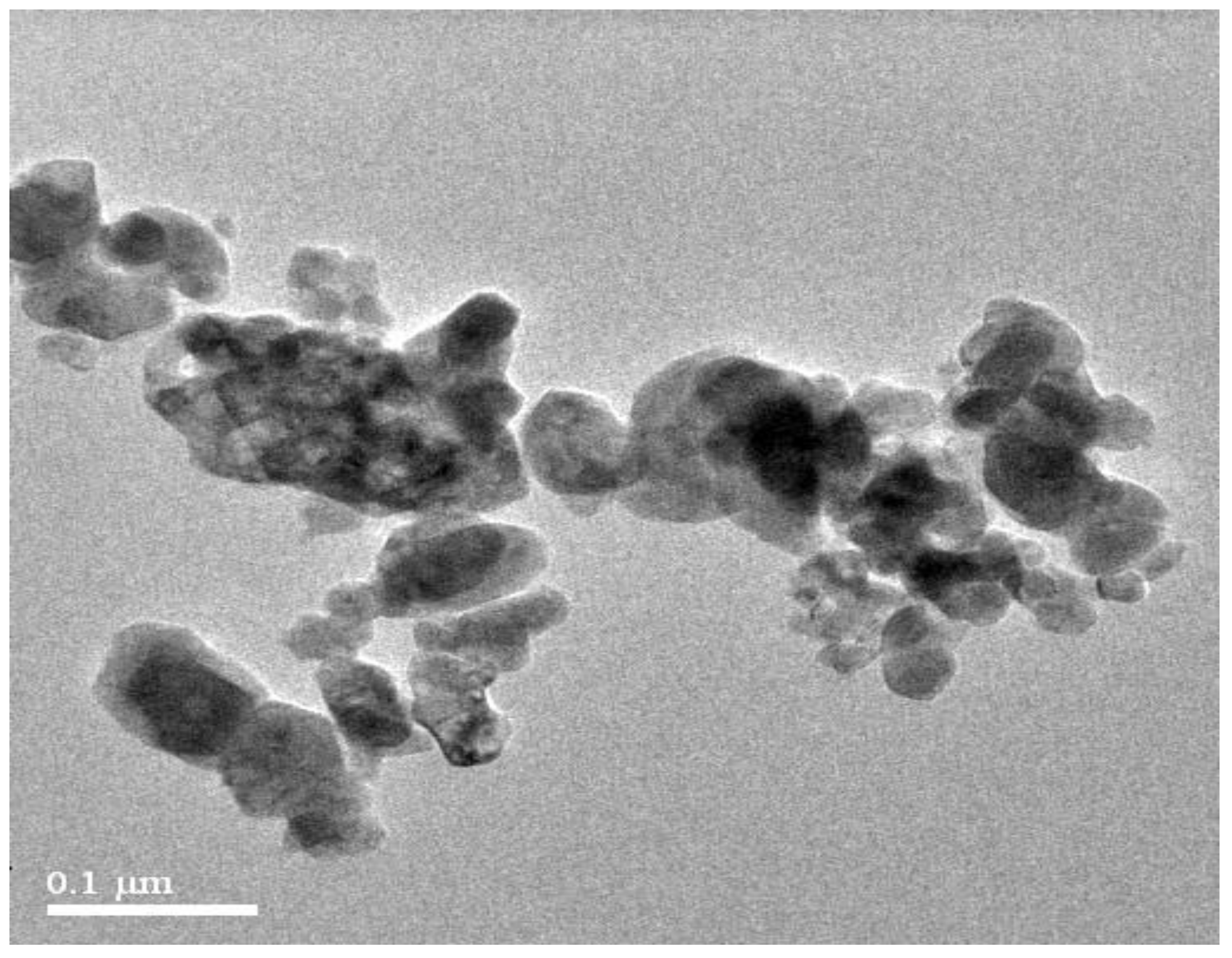



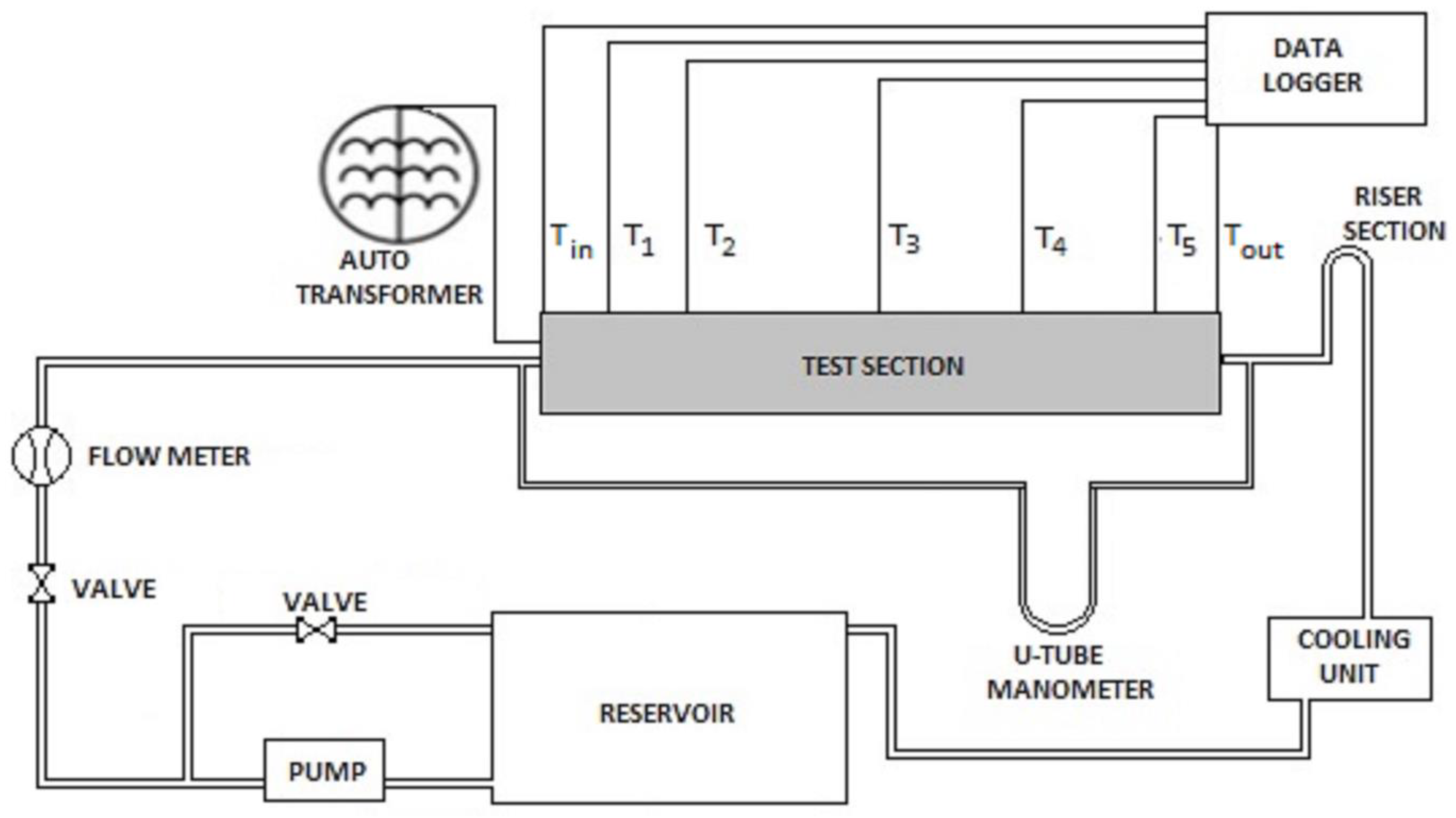

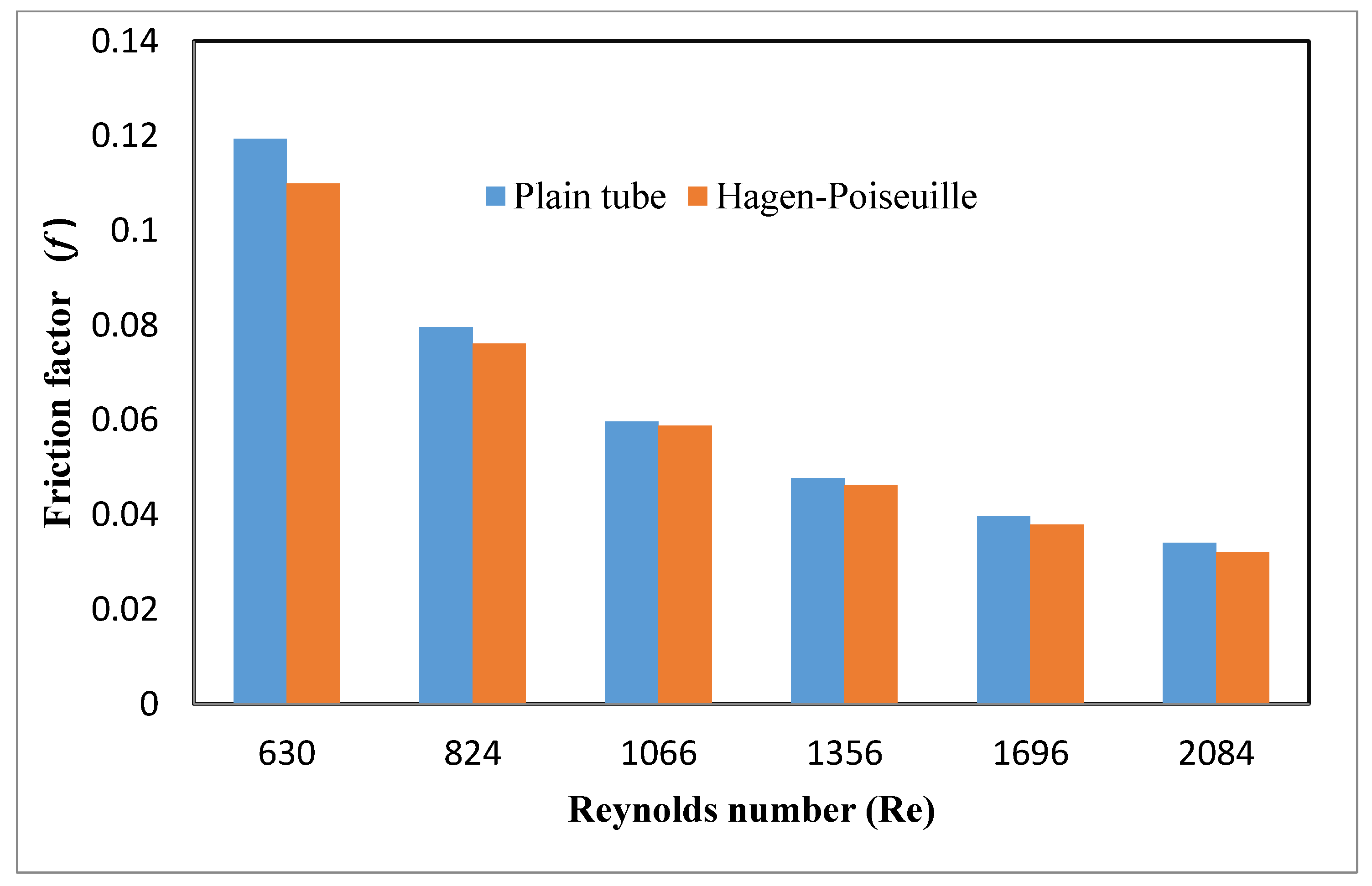
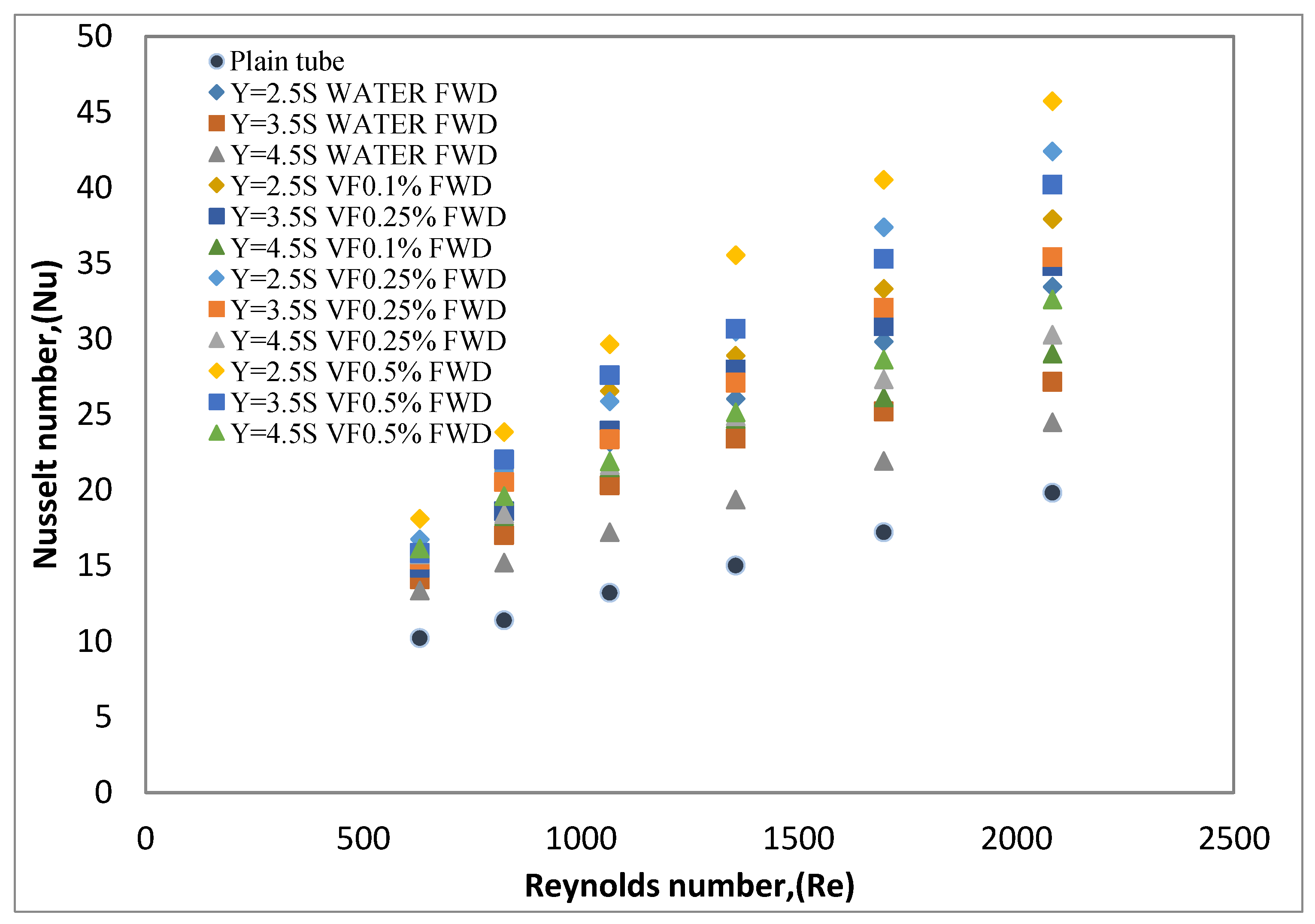

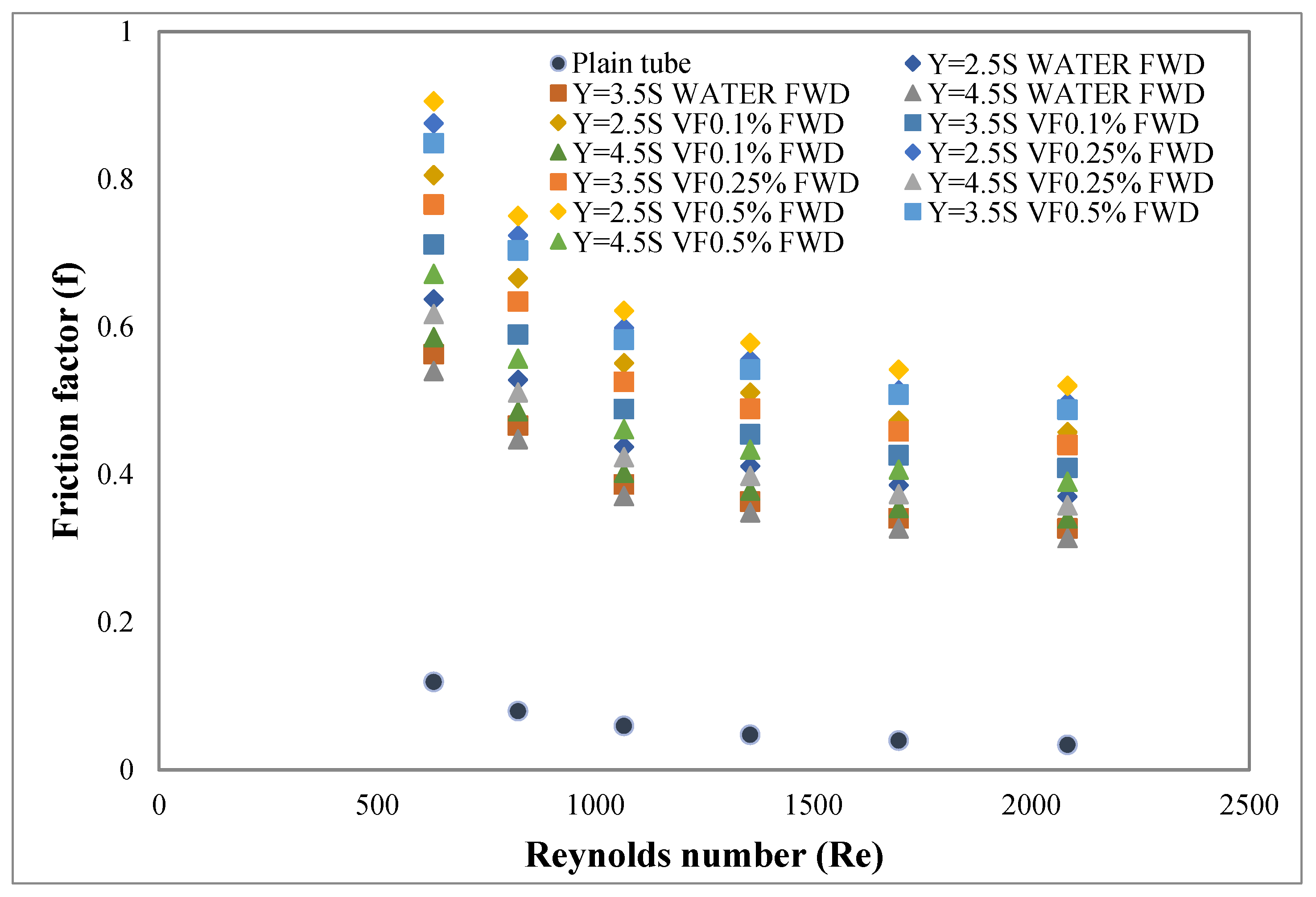
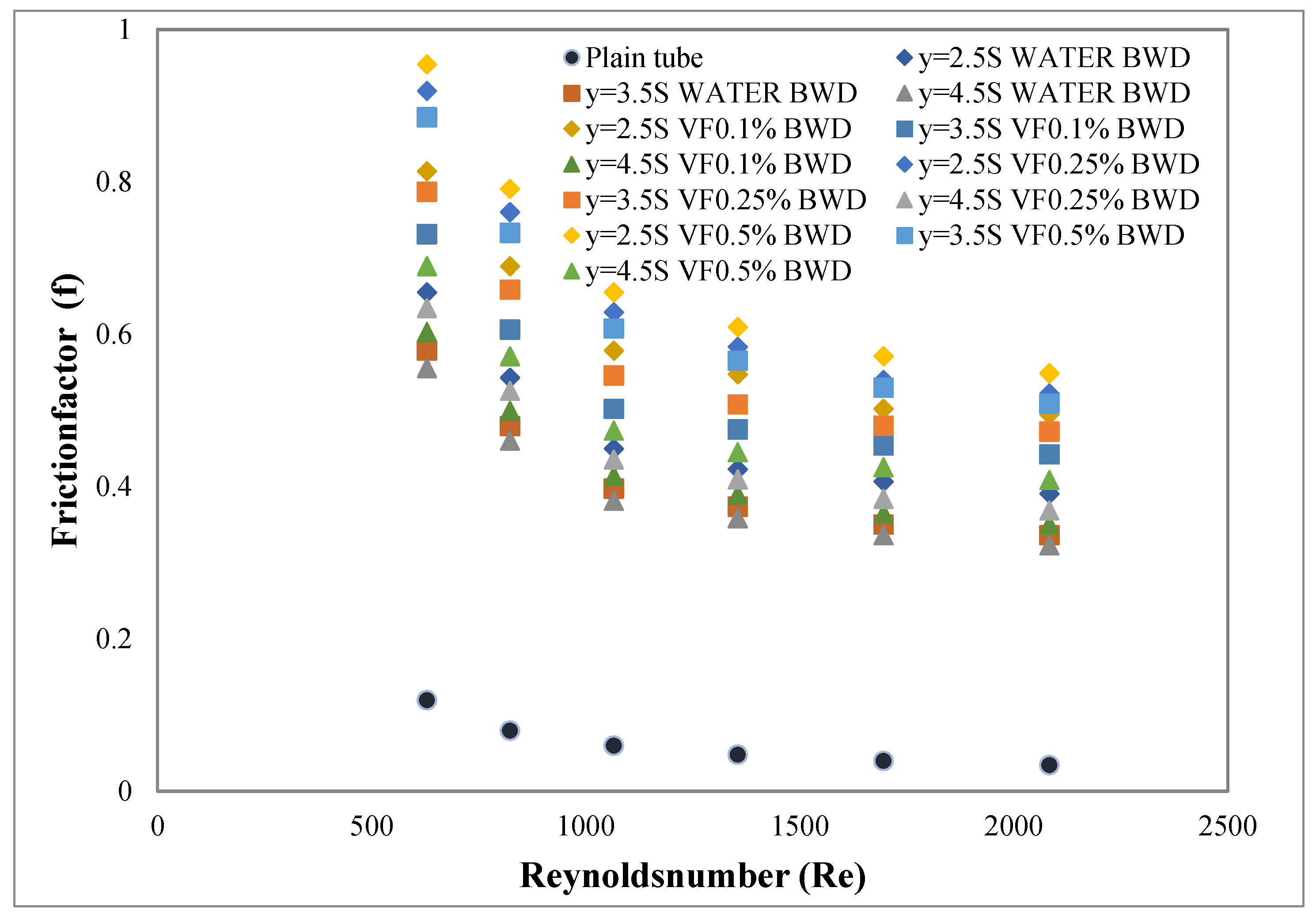

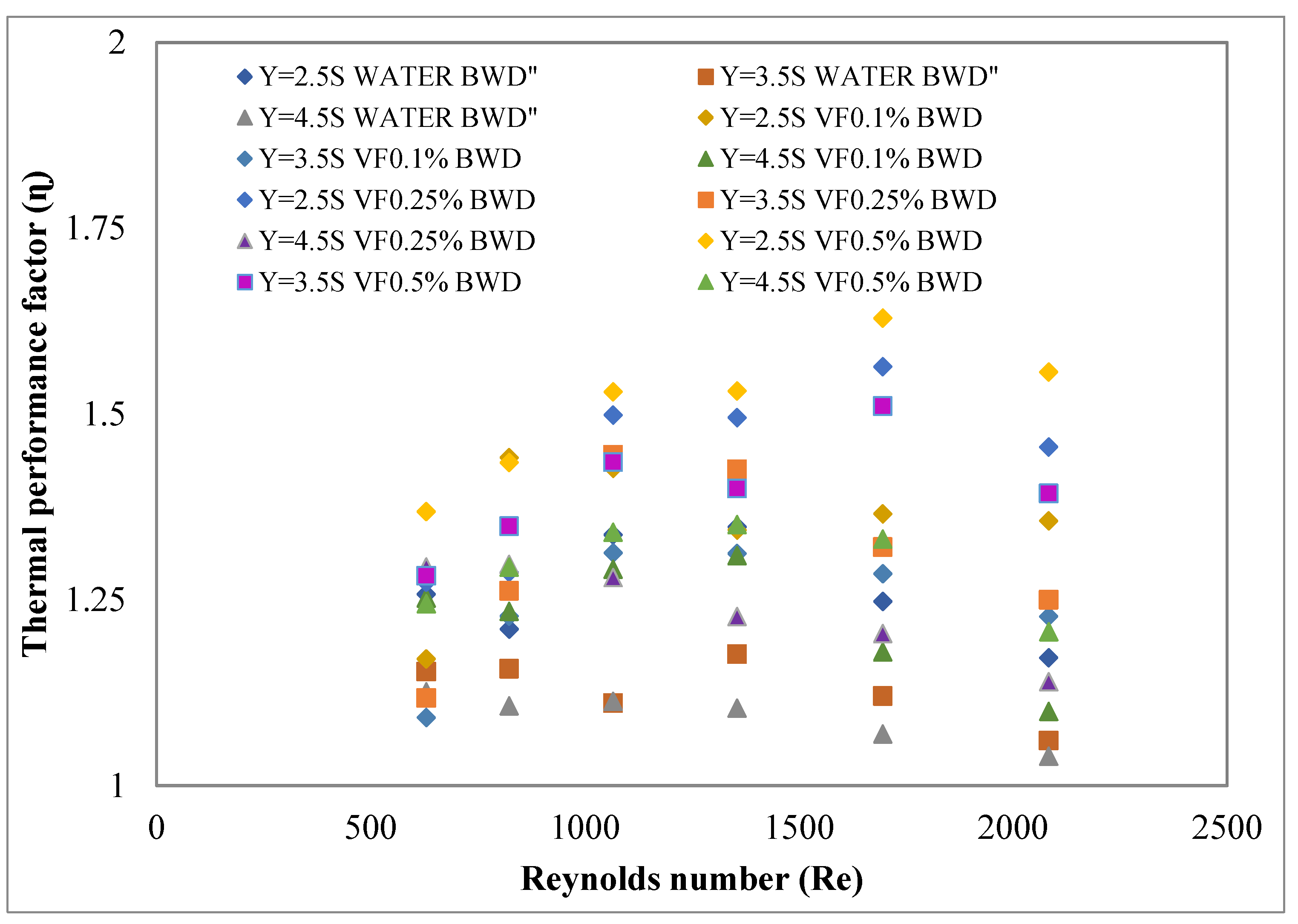
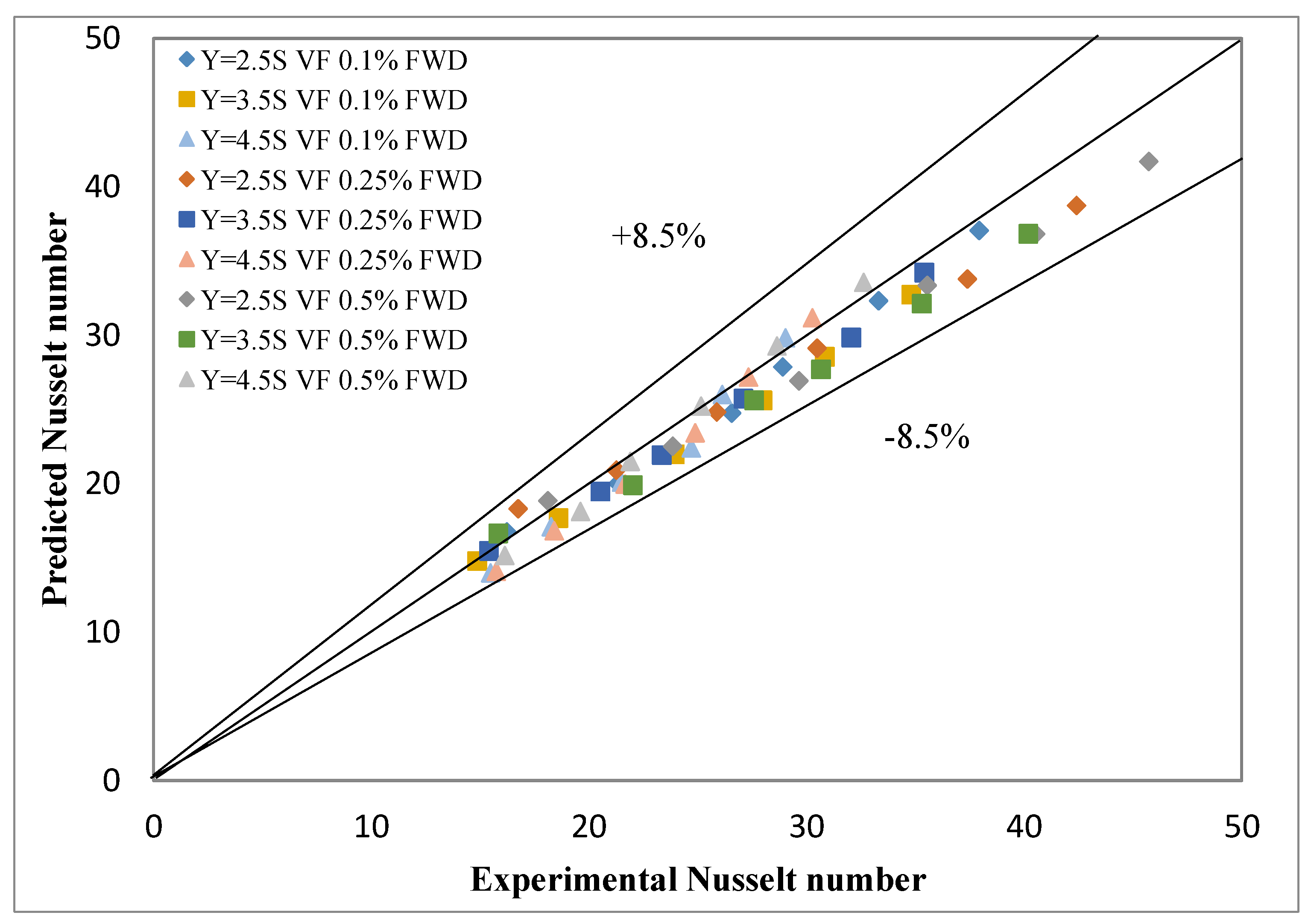

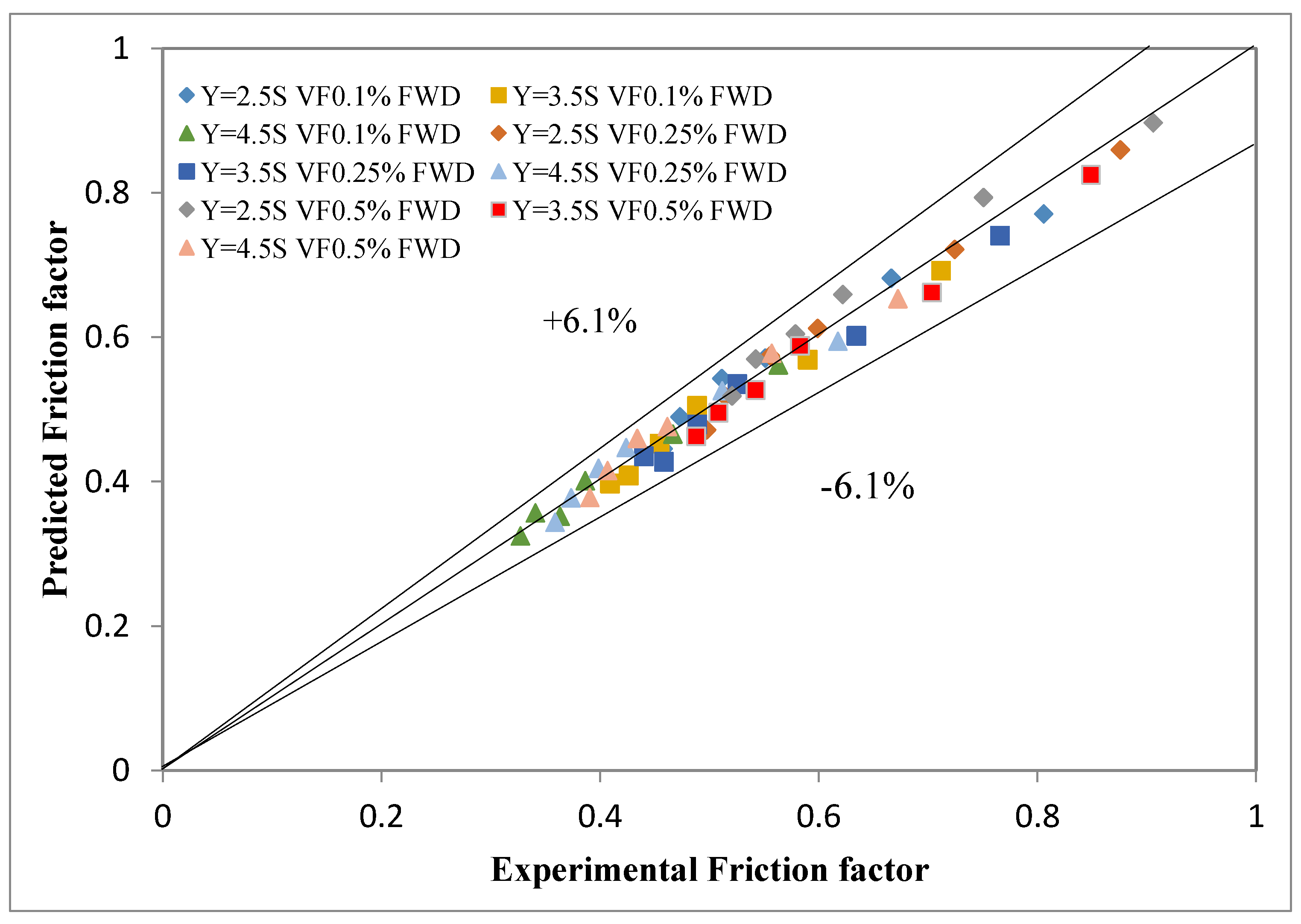

| Nanoparticle, DI Water and Nanofluids | Density (g/cm3) | Specific Heat (J/kg-K) | Dynamic Viscosity (mPa-sec) | Thermal Conductivity (W/m-K) | Prandtl Number (Pr = µ cp/k) |
|---|---|---|---|---|---|
| ZrO2 | 5600 | 418 | - | 2.80 | - |
| DI Water | 1000 | 4172 | 0.776 | 0.600 | 5.39 |
| φ = 0.10% | 1004.6 | 4157.18 | 0.833 | 0.615 | 5.63 |
| φ = 0.25% | 1011.5 | 4125.95 | 0.912 | 0.632 | 5.95 |
| φ = 0.50% | 1023 | 4075.08 | 0.956 | 0.657 | 5.92 |
| S. No | Pitch in mm | Diameter in mm | Twist Ratio (Y) |
|---|---|---|---|
| 1. | 25 | 10 | 2.5:1 |
| 2. | 35 | 10 | 3.5:1 |
| 3. | 45 | 10 | 4.5:1 |
| S. No. | Measured Quantity | Accuracy |
|---|---|---|
| 1 | Fluid temperature (Tf) | ±0.1 °C |
| 2 | Wall temperature (Tw) | ±0.1 °C |
| 3 | Pressure drop (Δh) | ±0.0033 m |
| 4 | Pipe inner diameter (Di) | ±0.000025 m |
| 6 | Pipe length (L) | ±0.001 m |
| 7 | Mass flow rate (m) | ±6.02 × 10−5 kg/s |
| 8 | Voltage (V) | ±0.600 V |
| 9 | Current (I) | ±0.0375 A |
| Twist Ratios | Volume Concentration (%) | |||||
|---|---|---|---|---|---|---|
| 0.1 | 0.25 | 0.5 | ||||
| FWD | BWD | FWD | BWD | FWD | BWD | |
| Y = 2.5 | 91.27 | 109.83 | 113.86 | 127.28 | 130.56 | 145.02 |
| Y = 3.5 | 75.59 | 86.47 | 78.62 | 91.94 | 102.72 | 116.57 |
| Y = 4.5 | 46.41 | 60.67 | 52.65 | 67.93 | 64.52 | 80.92 |
| Authors and Reference | Type of Insert | P/d Ratio Range | Working Fluid and Range of Reynolds Number | Thermal Performance Factor Range |
|---|---|---|---|---|
| Present data | Conical strip insert | 2.5 ≤ P/d ≤ 4.5 | ZrO2/DI water 600 ≤ Re ≤ 2100 | 1.1–1.67 |
| S. Chougule [57] | Screw Tape | 1.5 ≤ P/d ≤ 3 | CNT/water 0.1 ≤ φ ≤ 1 15,000 ≤ Pe ≤ 30,000 | 1.24–1.46 |
| M. Saeedinia [58] | Wire coil | 1.79 ≤ P/d ≤ 2.5 | CuO/Base oil 0.07 ≤ φ ≤ 3 10 ≤ Re ≤ 120 | 0.92–1.2 |
| K. Yoong Lim [59] | Twisted tape | 2.5 ≤ P/d ≤ 6 | Water 400 ≤ Re ≤ 1400 | 0.85–1.6 |
© 2020 by the authors. Licensee MDPI, Basel, Switzerland. This article is an open access article distributed under the terms and conditions of the Creative Commons Attribution (CC BY) license (http://creativecommons.org/licenses/by/4.0/).
Share and Cite
Shajahan, M.I.; Michael, J.J.; Arulprakasajothi, M.; Suresh, S.; Nasr, E.A.; Hussein, H.M.A. Effect of Conical Strip Inserts and ZrO2/DI-Water Nanofluid on Heat Transfer Augmentation: An Experimental Study. Energies 2020, 13, 4554. https://doi.org/10.3390/en13174554
Shajahan MI, Michael JJ, Arulprakasajothi M, Suresh S, Nasr EA, Hussein HMA. Effect of Conical Strip Inserts and ZrO2/DI-Water Nanofluid on Heat Transfer Augmentation: An Experimental Study. Energies. 2020; 13(17):4554. https://doi.org/10.3390/en13174554
Chicago/Turabian StyleShajahan, Mohamed Iqbal, Jee Joe Michael, M. Arulprakasajothi, Sivan Suresh, Emad Abouel Nasr, and H. M. A. Hussein. 2020. "Effect of Conical Strip Inserts and ZrO2/DI-Water Nanofluid on Heat Transfer Augmentation: An Experimental Study" Energies 13, no. 17: 4554. https://doi.org/10.3390/en13174554
APA StyleShajahan, M. I., Michael, J. J., Arulprakasajothi, M., Suresh, S., Nasr, E. A., & Hussein, H. M. A. (2020). Effect of Conical Strip Inserts and ZrO2/DI-Water Nanofluid on Heat Transfer Augmentation: An Experimental Study. Energies, 13(17), 4554. https://doi.org/10.3390/en13174554







